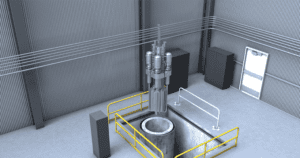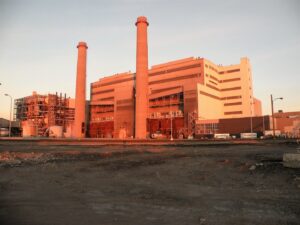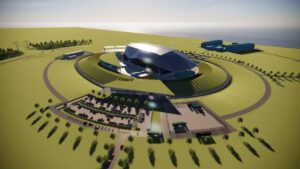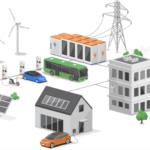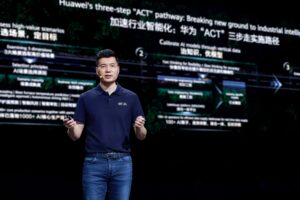
AI is advancing faster than ever into every industry and into every aspect of life. According to consultant firm KPMG, 66% of people and 78% of organizations use AI regularly, and at least 40% of jobs are going to be exposed to the impact of AI.
The energy sector is very much in the forefront of AI transformation. Enormous amounts of energy are needed to supply electricity to global AI data centers. Estimates vary from 23 gigawatts to 55 gigawatts. In the coming years, those numbers will rise sharply as AI grows in maturity and breadth of application.
To fulfill such energy demands, AI is being incorporated into the grid to improve efficiency, lower emissions, and boost reliability. For example, AI can be used to heighten the utilization of wind and solar resources by accurately analyzing weather data and comparing it to historical generation trends to align renewable output to real-time demand. As wind and solar generation are intermittent, AI is being harnessed to optimize when energy should be stored in battery systems and when it should be released for consumption. What is evolving is a much smarter grid where loads are adjusted optimally, potential failures are detected before they lead to serious outages, and predictive maintenance practices are fine tuned to create the right balance between cost, availability, and reliability.
This intelligent, resilient, and responsive grid is much closer to reality than many people think. Take the case of the China Southern Power Grid (CSG). One of the critical challenges CSG faced was how to leverage the vast amounts of data in its systems to identify transmission line defects. To solve this problem, it developed an AI-based large language model (LLM) called MegaWatt that is tailored to the power sector. MegaWatt is built on the Ascend MoE Expert Parallelism computing cluster (EP) and the MindSpore AI framework.
- Ascend EP is designed for high-volume, real-time tasks. It boosts AI processing throughput by 3.3 times compared to traditional solutions and greatly reduces latency when responding to queries.
- MindSpore utilizes natural language processing (NLP) to bridge the gap between human communication and computer understanding. This enables machines to process and respond to text and speech as seen in chatbots and virtual assistants.
Before being unleashed across the grid, the first major task preparing CSG data for training in the LLM that lies at the heart of the AI system. An end-to-end data governance process was used to clean, process, and label the data. With that firm foundation established, the model quickly learned the patterns, bottlenecks, and shortcomings of the grid. Since being deployed, MegaWatt has boosted defect recognition efficiency by five times, raised accuracy to over 90%, and enabled full automation—from image recognition to report generation.
How to Succeed with AI Across the Energy Sector
The experience gained by CSG and other cases has provided several lessons on how to ensure AI succeeds when it is deployed in the energy sector. Several of these key findings were shared at HUAWEI CONNECT 2025. They were developed over the course of these and other intelligent transformation projects. They are summarized below:
- AI models must be tailored to the industry in which they serve. The energy sector needs models that are fine tuned to their own high-quality and validated data. This allows more accurate and targeted models to be customized to specific use cases that solve customer-specific business challenges and create lasting competitive advantage.
- Carefully select the most appropriate areas in which to implement AI. The true value of AI goes far beyond efficiency. By integrating AI into core production workflows, more intelligent and more valuable products and services are generated, which boost confidence and serve to fuel enthusiasm for broader implementation of AI in the enterprise.
- Human-AI collaboration is fast becoming the new norm. AI systems are rapidly transitioning from the personal-assistant phase to becoming true partners to the business that work closely with employees to add value to all transactions and customer interactions.
- Systematic governance and risk management of AI are critical. AI agents cannot be allowed to act without accountability and oversight. All organizations need effective governance to ensure secure, sustainable, and trustworthy AI.
These principles of AI success have been incorporated into Huawei’s pathway for large-scale AI adoption. It follows the ACT approach:
- Assess high-value scenarios
- Calibrate AI models using vertical data,
- Transform business operations with scaled AI agents.
Assess high-value scenarios: Huawei has a robust AI Scenario Assessment Framework that evaluates business value, scenario maturity, and business–technology integration. This framework has helped customers identify and implement more than 1,000 core AI production scenarios.
Calibrate AI models using vertical data: Training high-quality models begins with data governance. Huawei provides a tool chain to help enterprises transform raw data into knowledge, and knowledge into models. For instance, Huawei’s unified lakehouse platform MRS helps enterprises stream massive raw data into a data lake, then convert it into structured data warehouse assets. This transforms idle data into ready-to-use data. In addition, it incorporates an end-to-end AI security protection system based on years of cyber security experience.
Transform business operations with scaled AI agents: Enterprise processes in the energy sector are complex, comprised of many scenarios and workloads. The Huawei platform can automatically generate agents, as well as workflows that can scale to more than 100 steps. This makes agent deployment much faster. When used in conjunction with our AI talent enablement program, business professionals can learn to rapidly and effectively develop, deploy, and operate AI agents.
For more information, visit https://e.huawei.com/en/


